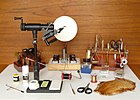Hare's Ear
| Hare's Ear | |
|---|---|
| Artificial fly | |
 Gold ribbed hare's ear | |
| Type | Nymph |
| Imitates | Mayfly larvae |
| History | |
| Creator | Unknown |
| Created | Unknown |
| Materials | |
| Typical sizes | 10-18 |
| Typical hooks | TMC 3769 |
| Thread | Black 6/0, 8/0 nylon |
| Tail | Guard hairs from hare's ear |
| Body | Hare's ear dubbing |
| Wing | Mottled Turkey tail feather |
| Ribbing | Fine gold wire or tinsel |
| Thorax | Dark hare's ear dubbing |
| Head | Black thread |
| Uses | |
| Primary use | Trout |
| Reference(s) | |
| Pattern references | Trout Flies-The Tier's Reference (1999) Hughes[1] |
The Hare's Ear or Gold Ribbed Hare’s Ear is a traditional artificial fly imitating an aquatic insect larva (nymph) used in fly fishing.[2]
Description
[edit]The Hare's Ear nymph fly is fished below the surface thus a wet fly or nymph. It is an older pattern that imitates a variety of aquatic life, including scuds, sow bugs, mayfly nymphs, and caddis larvae.
Tying
[edit]Soft hair and stiff bristles from a hare are wound around the shank of the hook and fastened with gold wire that suggests segmentation. Sometimes a gold bead head is added for weight and stability in the water and a strand of pheasant feather is added for a tail. The bead head can be fastened near the eye of the hook. This pattern is commonly tied on size 10 - 16 nymph hooks. Traditional colouring is a brown body with orange or brown thread.
Tactics
[edit]When this fly is immersed, the stiff fibers in the dubbing stand out and imitate the legs of an insect. Fish this lure below the surface with or without a small strike indicator and split-shot to help it sink. It is an effective pattern throughout the year because it covers a broad spectrum of prey that are active in every season.
References
[edit]- ^ Hughes, Dave (1999). Trout Flies-The Tier's Reference. Mechanicsburg, PA: Stackpole Books. pp. 88–90. ISBN 978-0-8117-1601-7.
- ^ Dave Hughes (2000). Essential Trout Flies. Stackpole Books. ISBN 0-8117-2748-3.
External links
[edit]- Heptageniidae Mayfly Pictures and Behavior – Details about the mayfly family usually imitated by the Hare's Ear nymph.



